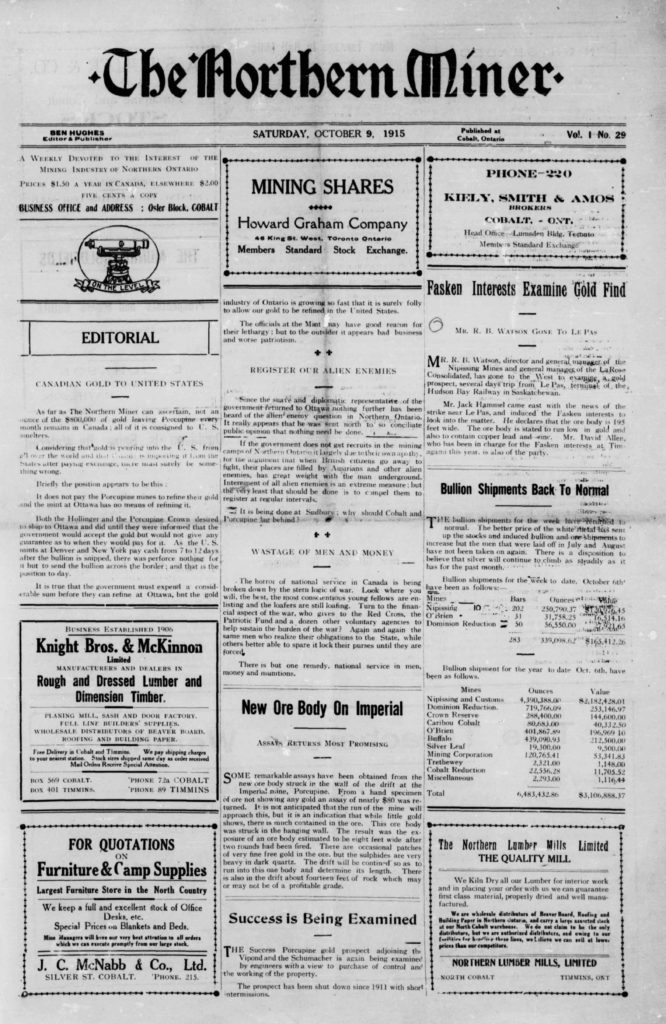To help mark 110 years at The Northern Miner, we’ve started a feature each month to include some Blasts from the Past. Take a look at page 39 in the April print issue (or below here) and you’ll see the Miner in 1915. The lead story that week in October shows the United States taking all of Ontario’s gold ore from the new Porcupine mine near Timmins, Ont. because Canada lacks its own metal refining.
Here’s the Miner in 1915:
“It is true that the government must expend a considerable sum before they can refine at Ottawa, but the gold industry in Ontario is growing so fast that it is surely folly to allow our gold to be refined in the United States. The officials at the Mint may have good reason for their lethargy; but to the outsider it appears bad business and worse patriotism.”

Some things never change. Substitute in critical minerals and China, and cross-border issues are even more profound these days. The Asian giant controls most metals refining and the West is scrambling to build its own.
Of course, the more immediate comparison for Canadians is the tariff war. It’s driving the discourse in a federal election campaign riddled with trade threats from the Oval Office. We’ll soon know what level of reciprocal tariffs President Donald Trump is imposing around the planet on his so-called Liberation Day, April 2.
But you may not. Things are reliably unpredictable, which is why gold surpassed the $3,100-an-oz. milestone on Monday, months or a year ahead of what most analysts were saying as recently as January.
How many tariffs?
To recap, Trump delayed 25% tariffs across all Mexican and Canadian goods — with oil and minerals at 10% — until April 2, the same day as the global reciprocal tariffs are to take effect. Separately, he imposed 25% tariffs on all aluminum and steel imports when Canada supplied nearly two- thirds of U.S. aluminum demand last year.
Canada replied with $30 billion in retaliatory tariffs against the 25% move on general goods (even though Trump paused the measure) plus $29.8 billion targeted on U.S. steel and aluminum. A third wave of up to $125 billion in retaliation was prepared but has been postponed until at least April 2.
Then before the end of March, Trump slapped 25% tariffs on all foreign-made vehicles to take effect April 3. Again, the details weren’t clear so gold rose and stocks sank.
The Dow Jones Industrial Average has fallen 1,486.07 points or 3.4% since the inauguration in January. March 10 saw the biggest one-day drop at 890 points so Trump is still safe from his decade-old tweet: “If the Dow Joans [sic] ever falls more than 1000 “points” in a single day the sitting president should be “loaded” into a very big cannon and shot into the sun at tremendous speed. No excuses!”
These days in Canada there’s a new patriotism. The rallying cry is “elbows up!” — Scarborough’s Mike Myers even slipped the Gordie Howe reference into the closing credits of a recent “Saturday Night Live” episode. It was a like a coded transmission behind enemy lines, from a bunker still manned by Canadian Lorne Michaels.
54-40
Elbows up is somewhat like the campaign slogan that backed president James Polk, whose manifest destiny goals were mentioned before in this space. Polk was running for election in 1844 when supporters chanted “54-40 or fight!” But elbows up is definitely Canadian in its defensive posture, a bit more polite anyway.
Long before there was a solidly good Canadian rock band named 54-40 from Tsawwassen, B.C., the issue concerned the Oregon Territory that American expansionists wanted to secure all the way up to then-Russia owned Alaska at 54°40′ north latitude. The dispute ended with an agreement in 1846 setting the 49th parallel as the border there.
Trump, of course, has called the line arbitrary and wants to erase it. Canadian sovereignty and tariffs also dominated the 1988 Canadian election when prime minister Brian Mulroney championed his free trade deal with U.S. president Ronald Reagan. Even my libertarian father was concerned then for the Canuck economy and jobs.
Like now, many resource-rich provinces, especially in the West, supported the deal for its promise of stable access to U.S. markets, including for mining exports. Critics, including Liberal John Turner and the NDP’s Ed Broadbent, feared it would undermine Canadian sovereignty over natural resources.
Policy shift
Despite Turner’s impassioned opposition during the televised leaders’ debates — including a widely praised performance — the Progressive Conservatives won a majority, and the agreement moved forward. Later, Liberal Jean Chretien shifted policy to accept free trade as a reality and the NDP came to do likewise, though ever supportive of workers’ rights.
So now most Canadians support continental free trade and don’t want to lose it, even though Trump has given his neighbours a wake-up call on being self-sufficient in everything from autos to defence.
Many Canadians outside of mining are also understanding the industry’s heightened role in modern applications. When a comic at a Rotary Club benefit the other night joked that her boyfriend stole her IUD for the copper in it, it was clear the battle for minerals is percolating through the public domain.
Talking about elevated metal prices, think back to the gold being produced in that 1915 article – C$800,000 for a month back then. Given inflation and a spot gold price around $3,100 per oz. now, it would be worth a staggering C$158 million today.


Be the first to comment on "TNM Editorial: The price of metals, the value of elections"